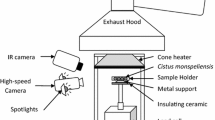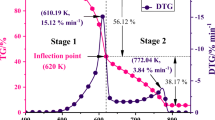Abstract
The capacity of firebrands for ignition is closely related to fuel conditions which include fuel type, moisture content (MC), fuel distribution and fuel bulk density, among which MC is the most important. In this paper, a new correlation between ignition time (t ig) and MC of fuels is established by theoretical consideration of the heat transfer processes that occur when fuels are ignited by glowing firebrands that have settled on a fuel bed. The results suggest a linear relationship between t 1/2ig and MC. This linear correlation is verified by data from six groups of firebrand ignition experiments in which pine needles were used as the fuel to be ignited, with MCs ranging from 12.9% to 65%. The wind speed during experimentation was maintained at 3 m/s (±0.2 m/s). The studies by Jolly et al. support the theoretical correlation.






Similar content being viewed by others
Abbreviations
- A :
-
Bottom surface of firebrand
- A loss :
-
Surface of firebrand that is exposed to air
- C w :
-
Specific heat of water
- C p :
-
Specific heat of dry pine needles
- h c :
-
Heat convection coefficient
- h r :
-
Heat radiation coefficient
- h T :
-
Equivalent coefficient of heat loss
- ΔH c :
-
Combustion heat of glowing firebrand
- k :
-
Heat conduction coefficient
- L w :
-
Latent heat of water vaporization
- m :
-
Mass of fuels involved in ignition
- m 0 :
-
Initial mass of firebrand
- Δm :
-
Mass loss of firebrand
- m′:
-
Mean mass loss rate of firebrand
- M :
-
Moisture content of pine needles
- M dry :
-
Mass of samples after oven drying
- M wet :
-
Mass of samples before oven drying
- q :
-
Heat required for ignition of moist fuel (dry mass basis)
- q s :
-
Heat required for ignition of unit mass of dry pine needles
- q w :
-
Heat required for water evaporation of unit mass of dry pine needles
- \( q_{\text{loss}}^{\prime \prime } \) :
-
Heat flow density of heat loss
- Q comb :
-
Heat released by firebrand combustion
- Q ig :
-
The total heat required for ignition
- Q loss :
-
Heat loss of firebrand
- Q trans :
-
Heat transfer from firebrand to fuels
- t :
-
Time
- t b :
-
Time to complete consumption of firebrand
- t ig :
-
Ignition time
- T 0 :
-
Ambient temperature
- T f :
-
Firebrand temperature
- T ig :
-
Ignition temperature of pine needle
- V f :
-
Initial volume of firebrand
- Z :
-
Height of firebrand
- α :
-
Heat diffusivity coefficient of material
- δ :
-
Characteristic dimension of material
- ε :
-
Emissivity
- ρ :
-
Density of pine needle
- ρ f :
-
Initial density of firebrand
- σ :
-
Stefan–Boltzman constant
References
Koo E, Pagni PJ, Weise DR, Woycheese JP (2010) Firebrands and spotting ignition in large-scale fires. Int J Wildland Fire 19(7):818–843. doi:10.1071/Wf07119
Alexander ME (2009) Some pragmatic thoughts on the prediction of spotting in wildland fires,—powerpoint. Presentation at the MITACS/GEOIDE conference on forest fire modelling, June 22–23, 2009, Hinton, AB
Anthenien R, Tse S, Carlosfernandezpello A (2006) On the trajectories of embers initially elevated or lofted by small scale ground fire plumes in high winds. Fire Saf J 41(5):349–363. doi:10.1016/j.firesaf.2006.01.005
Lee SL, Hellman JM (1970) Firebrand trajectory study using an empirical velocity-dependent burning law. Combust Flame 15(3):265–274. doi:10.1016/0010-2180(70)90006-4
Lee SL, Hellman JM (1969) Study of firebrand trajectories in a turbulent swirling natural convection plume. Combust Flame 13(6):645–655. doi:10.1016/0010-2180(69)90072-8
Muraszew A, Fedele JB, Kuby WC (1977) Trajectory of firebrands in and out of fire whirls. Combust Flame 30:321–324. doi:10.1016/0010-2180(77)90081-5
Tarifa C, Del Notario P, Moreno F, Villa A (1967) Transport and combustion of firebrands, final report of grants FG-SP-11 and FG-SP-146, vol 2. USDA, Madrid
Tse SD, Fernandez-Pello AC (1998) On the flight paths of metal particles and embers generated by power lines in high winds—a potential source of wildland fires. Fire Saf J 30(4):333–356
Blackmarr WH (1972) Moisture content influences ignitability of slash pine litter. Res Note SE-173. U.S. Department of Agriculture, Forest Service, Southeastern Forest Experiment Station, Asheville
Anderson SAJ, Anderson WR (2010) Ignition and fire spread thresholds in gorse (Ulex europaeus). Int J Wildland Fire 19(5):589–598
Davies GM, Legg CJ (2011) Fuel moisture thresholds in the flammability of Calluna vulgaris. Fire Technol 47:421–436
Manzello SL, Cleary TG, Shields JR, Yang JC (2006) On the ignition of fuel beds by firebrands. Fire Mater 30(1):77–87. doi:10.1002/Fam.901
Manzello SL, Park SH, Cleary TG (2009) Investigation on the ability of glowing firebrands deposited within crevices to ignite common building materials. Fire Saf J 44(6):894–900
Ganteaume A, Lampin-Maillet C, Guijarro M, Hernando C, Jappiot M, Fonturbel T, Perez-Gorostiaga P, Vega JA (2009) Spot fires: fuel bed flammability and capability of firebrands to ignite fuel beds. Int J Wildland Fire 18(8):951–969. doi:10.1071/Wf07111
Dimitrakopoulos A, Papaioannou KK (2001) Flammability assessment of Mediterranean forest fuels. Fire Technol 37(2):143–152
Pellizzaro G, Duce P, Ventura A, Zara P (2007) Seasonal variations of live moisture content and ignitability in shrubs of the Mediterranean Basin. Int J Wildland Fire 16(5):633–641
Quintoere JG (2006) Fundamentals of fire phenomena. Wiley, Chichester
Lautenberger C, Fernandez-Pello AC (2008) Modeling ignition of combustible fuel beds by embers and heated particles. In: Forest fires 2008
Incropera FP, De Witt DP, Bergman TL, Lavine AS (2007) Fundamentals of heat and mass transfer, 6th edn. Wiley, New York
Jolly M, McAllister S, Finney M, Hadlow A (2010) Time to ignition is influenced by both moisture content and soluble carbohydrates in live Douglas fir and Lodgepole pine needles. In: Viegas DX (ed) Proceedings of the VI international conference on forest fire research, Coimbra, Portugal, 15–18 November 2010. Coimbra: University of Coimbra
Acknowledgments
This work was sponsored by the National Natural Science Foundation of China under Grant 51120165001 and 51076148, and National Key Technology R&D Program under Grant 2011BAK07B01-02. Naian Liu was supported by National Basic Research Program of China (973 Program, NO. 2012CB719702) and the Fundamental Research Funds for the Central Universities (No. WK2320000014). Yanlong Shan was supported by National Natural Science Foundation of China (No. 30900189), and Project of Jilin Province Ministry of Education (2009-402).
Author information
Authors and Affiliations
Corresponding author
Rights and permissions
About this article
Cite this article
Yin, P., Liu, N., Chen, H. et al. New Correlation Between Ignition Time and Moisture Content for Pine Needles Attacked by Firebrands. Fire Technol 50, 79–91 (2014). https://doi.org/10.1007/s10694-012-0272-y
Received:
Accepted:
Published:
Issue Date:
DOI: https://doi.org/10.1007/s10694-012-0272-y




